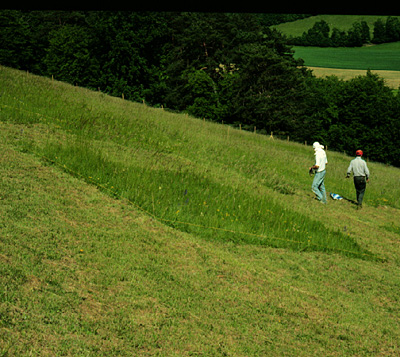Effects of habitat fragmentation on populations and genetic variability
Bruno Baur ![]() , Daniel Schlaepfer, Peter Stoll, Hans-Peter Rusterholz, Brigitte Braschler, Jari Niemelš (University of Helsinki, Finland)
, Daniel Schlaepfer, Peter Stoll, Hans-Peter Rusterholz, Brigitte Braschler, Jari Niemelš (University of Helsinki, Finland)
Due to human pressures, ecosystems are being rapidly modified and habitats fragmented, species are becoming extinct and gene pools are being narrowed - and all this at an increasing and historically unprecedented rate. In a field experiment we fragmented calcareous grassland into patches of different size over a period of 7 years. The experimental design (block design, 4 fragments and 4 control patches in each block, 12 blocks distributed over 3 sites (Nenzlingen, Movelier and Vicques in the Swiss Jura mountains) circumvented confounding factors such as differences in shape, age and degree of isolation of fragments. The main aims of the project were to simultaneously evaluate the influence of habitat fragmentation on species diversity (in vascular plants, grasshoppers, ants, aphids, spiders, ground beetles, terrestrial gastropods and butterflies), population viability (in a fungus, several plant and gastropod species) and genetic diversity in selected groups of organisms.
The first results of the experiment show that species interactions such as seed predation or pathogen-plant relationships seem to be most sensitive to habitat fragmentation. The experimental fragmentation caused extinction of land snail species in some isolated fragments. However, different snail species respond in different ways to the fragmentation. Butterflies and bumblebees visited flowers in the fragments less frequently than those in the control patches. This indicates that even small-scale fragmentation can influence the foraging behaviour of pollinators, which in turn may affect the fitness of insect-pollinated plants.
Keywords: population viability - population dynamics - edge effect - calcareous grassland - biodiversity
Selected publications
Schlaepfer DR, Braschler B, Rusterholz H-P & Baur B (2018) — Genetic effects of anthropogenic habitat fragmentation on remnant animal and plant populations: a meta-analysis — Ecosphere 9: e02488
Braschler B & Baur B (2016) — Diverse effects of a seven-year experimental grassland fragmentation on major invertebrate groups — PLOS ONE 11: e0149567
Rusterholz H-P & Baur B (2010) — Delayed response in a plant-pollinator system to experimental grassland fragmentation — Oecologia 163: 141–152
Stoll P, Oggier P & Baur B (2009) — Population dynamics of six land snail species in experimentally fragmented grassland — Journal of Animal Ecology 78: 236–246
Braschler B, Marini L, Thommen GH & Baur B (2009) — Effects of small-scale grassland fragmentation and frequent mowing on population density and species diversity of orthopterans: a long-term study — Ecological Entomology 34: 321–329
Stoll P, Dolt C, Goverde M & Baur B (2006) — Experimental habitat fragmentation and invertebrate grazing in a herbaceous grassland species — Basic and Applied Ecology 7: 307–319
Joshi J, Stoll P, Rusterholz H-P, Schmid B, Dolt C & Baur B (2006) — Small-scale experimental habitat fragmentation reduces colonization rates in species-rich grasslands — Oecologia 148: 144–152
Dolt C, Goverde M & Baur B (2005) — Effects of experimental small-scale habitat fragmentation on above-and below-ground plant biomass in calcareous grasslands — Acta Oecologica 27: 49–56
Braschler B & Baur B (2005) — Experimental small-scale grassland fragmentation alters competitive interactions among ant species — Oecologia 143: 291–300
List of all publications related to this project
![]()

![]()